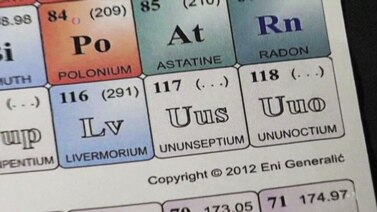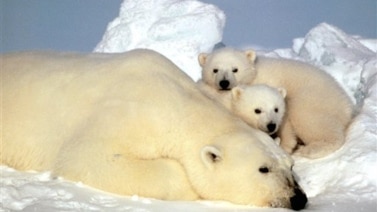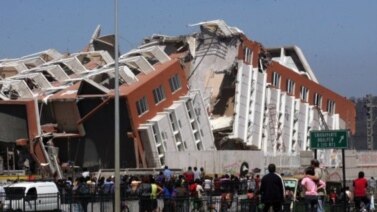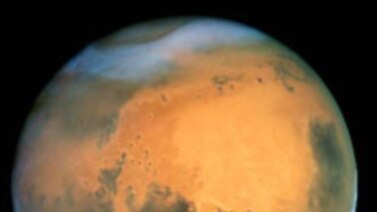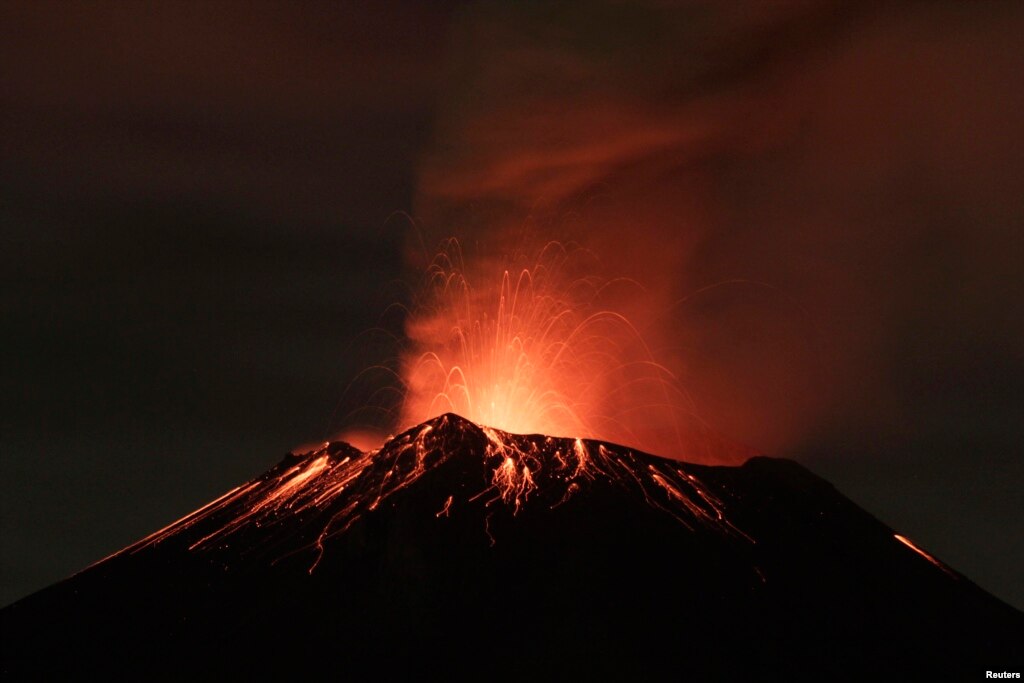
From VOA Learning English, this is SCIENCE IN THE NEWS, in Special English. I’m Kelly Jean Kelly.
And I’m Christopher Cruise. Scientists who study the Earth tell us the continents and ocean floors are always moving. This movement sometimes can be violent, causing death and destruction. Today, we examine what causes earthquakes and volcanic activity.
The first pictures of Earth taken from space showed a solid ball covered by brown and green landmasses and blue-green oceans. It appeared as if the Earth had always looked that way -- and always would.
Yet the surface of the Earth is not as solid or as permanent as had been thought. Scientists found that the surface of our planet is always in motion. Continents move about the Earth like huge ships at sea, floating on pieces of the Earth’s outer skin, or crust. New crust is created as melted rock pushes up from inside the planet. Old crust is destroyed as it moves toward the hot rock and melts.
In the twentieth century, scientists began to understand that the Earth is a great, living -- and moving -- structure. Some experts say this understanding is one of the most important revolutions in scientific thought.
The knowledge of the Earth’s constant motion is based on the work of scientists who study the movement of the continents. This process is called plate tectonics. Earthquakes and volcanic activity are a result of that process. Plate tectonics is the area of science that explains why the Earth’s surface moves, and how those changes cause earthquakes and volcanic activity.
We Are Walking on Eggshells
Scientists say the surface of the Earth is cracked like a huge eggshell. They call these pieces tectonic plates. As many as 20 of them cover the Earth. The plates sometimes hit each other, and sometimes move away from each other. Because some continents are above two plates, the continents move when the plates do.
The movement of tectonic plates can cause earthquakes and volcanoes. Modern instruments show that about 90 percent of all earthquakes happen along a few lines in several places around the Earth. These lines follow underwater mountains, where hot liquid rock flows up from deep inside the Earth. Sometimes, the melted rock comes out with a great burst of pressure. This forces apart pieces of the Earth’s surface in a violent earthquake.
Some earthquakes take place at the edges of continents. Pressure increases as two plates move against each other. When this happens, one plate moves past the other, suddenly causing the Earth’s surface to split open.
One example of this pressure is found on the west coast of the United States. Part of California is on what is known as the Pacific plate. The other part of the state is on what is known as the North American plate.
Scientists say the Pacific plate is moving toward the northwest, while the North American plate is moving toward the southeast. These two huge plates come together at what is called a fault line. This line between the plates in California is called the San Andreas Fault. It is along or near this fault line that most of California’s earthquakes take place, as the two tectonic plates move in different directions.
The city of Los Angeles is about 50 kilometers from the San Andreas Fault. Many smaller fault lines can be found throughout the Los Angeles area.
German Scientist Lead the Way
As we noted earlier, scientists began making major discoveries about plate tectonics in the 20th century. One of those scientists was Alfred Wegener of Germany. One hundred years ago, he proposed that the continents had moved and were still moving.
Wegener said the idea came to him when he saw that the coasts of South America and Africa fit together like two pieces of a puzzle. He suspected that the two continents might have once been one, and then split apart. Wegener believed the continents had once been part of a huge area of land that he called Pangaea. He said the huge continent had split more than 200 million years ago. And, he said the pieces were still floating apart.
Alfred Wegener investigated the idea that continents move. He noted that a line of mountains that appears from east to west in South Africa looks almost exactly the same as a line of mountains in Argentina … on the other side of the Atlantic Ocean. He found fossil remains of the same kind of an early plant in parts of Africa, South America, India, Australia and even Antarctica.
Wegener said the mountains and fossils were evidence that all the land on Earth was united at some time in the distant past. Wegener also noted differences between the continents and the ocean floor. He said the oceans were more than just low places that had filled with water. Even if the water was removed, he said, a person would still see differences between the continents and the ocean floor.
Also, the continents and the ocean floor are not made of the same kind of rock. The continents are made of a granite-like rock. Granite is made when hot, liquid rock cools and hardens under the Earth’s surface. The ocean floor is basalt rock, a mixture of silicon and magnesium. The German scientist said the lighter continental rock floated up through the heavier basalt rock of the ocean floor.
Support for Wegener’s ideas did not come until the 1950s. Two American scientists found that the continents moved as new sea floor was created under the Atlantic Ocean. Harry Hess and Robert Dietz said a thin valley in the Atlantic was a place where the ocean floor splits. They said hot melted material flows up from deep inside the Earth through the split. As the hot material reaches the ocean floor, it spreads out, cools and hardens. It becomes new ocean floor.
The Americans proposed that the floor of the Atlantic Ocean is moving away from each side of the split. The movement is very slow -- a few centimeters a year. In time, they said, the moving ocean floor is blocked when it comes up against the edge of a continent. Then it is forced down under the continent, deep into the Earth, where it is melted again.
Harry Hess and Robert Dietz said this spreading does not make the Earth bigger. As new ocean floor is created, an equal amount is destroyed.
The two scientists said Wegener was correct. The continents do move as new material from the center of the Earth rises, hardens and pushes older pieces of the Earth away from each other. The continents are moving all the time, although we cannot feel it. They called their theory “sea floor spreading.” The theory explains that as the sea floor spreads, the tectonic plates are pushed and pulled in different directions.
The idea of plate tectonics explains both volcanoes and earthquakes. Many of the world’s volcanoes are found at the edges of plates, where geologic activity is intense. The large number of volcanoes around the Pacific plate has earned this area the name “Ring of Fire.” Volcanoes are also found in the middle of plates, where there is a well of melted rock. Scientists call these wells “hot spots.” A hot spot does not move. However, as the plate moves over it, a line of volcanoes is formed. The Hawaiian Islands were created in the Pacific Ocean as the plate moved slowly over a hot spot. This process is continuing, as the plate continues to move.
Moving Plates Cause Violence
Volcanoes and earthquakes are among the most frightening events that nature can produce. They cause us to remember that the Earth is not as solid and unchanging as we might like to think. An American scientist says because of expected population increases, more people will die in earthquakes. And he thinks there will be more of what he calls “catastrophic earthquakes,” where large numbers of people die.
Thomas Holzer is with the United States Geological Survey. He and James Savage, another USGS worker, studied catastrophic earthquakes, in which more than 50,000 people died. The two men also estimated the total number of deaths over the past 500 years. They compared those events to estimates of world population. They found that the number of “catastrophic earthquakes” has risen as the human population grows.
The scientists are predicting about 21 catastrophic earthquakes in the 21st century. Only seven such earthquakes took place in the last century. And they say total earthquake deaths could more than double if the world population grows to 10.1 billion by 2100.
This SCIENCE IN THE NEWS program was written by Christopher Cruise. Our producer was June Simms. I’m Kelly Jean Kelly.
And I’m Christopher Cruise. Join us again next week for more news about science in Special English on the Voice of America.
